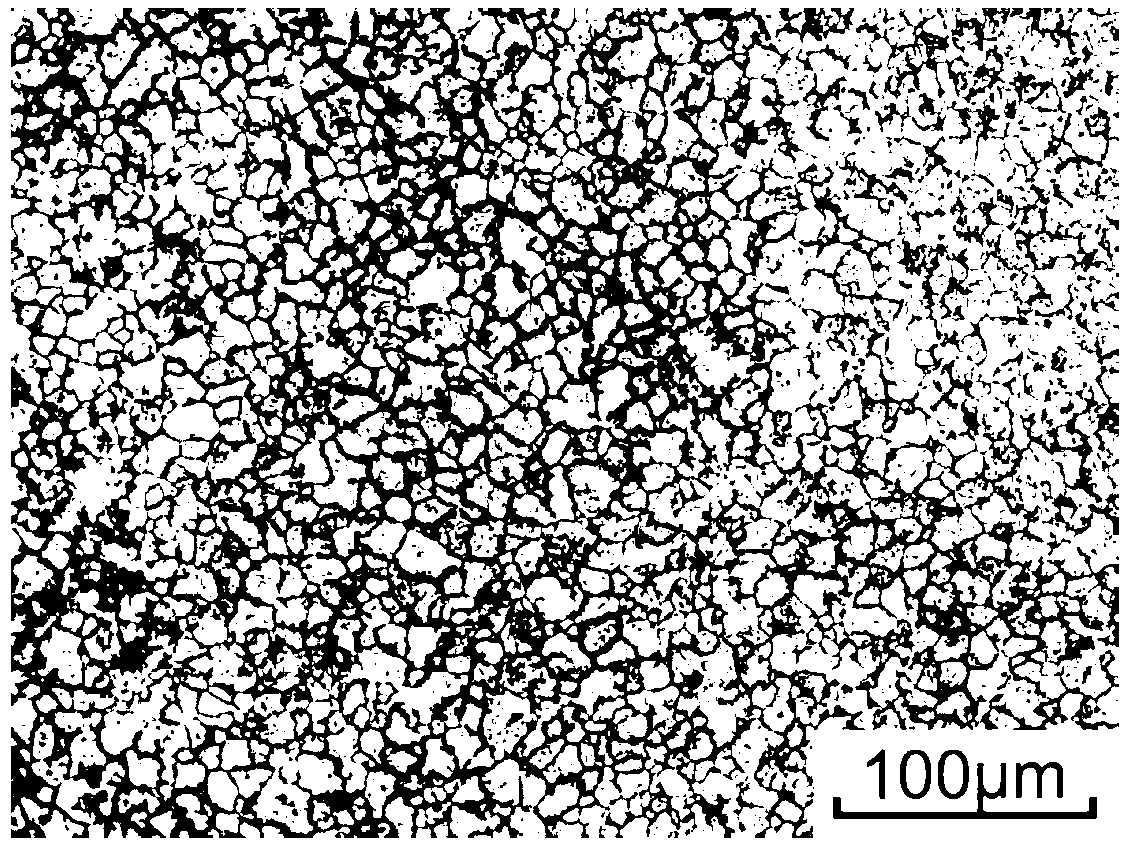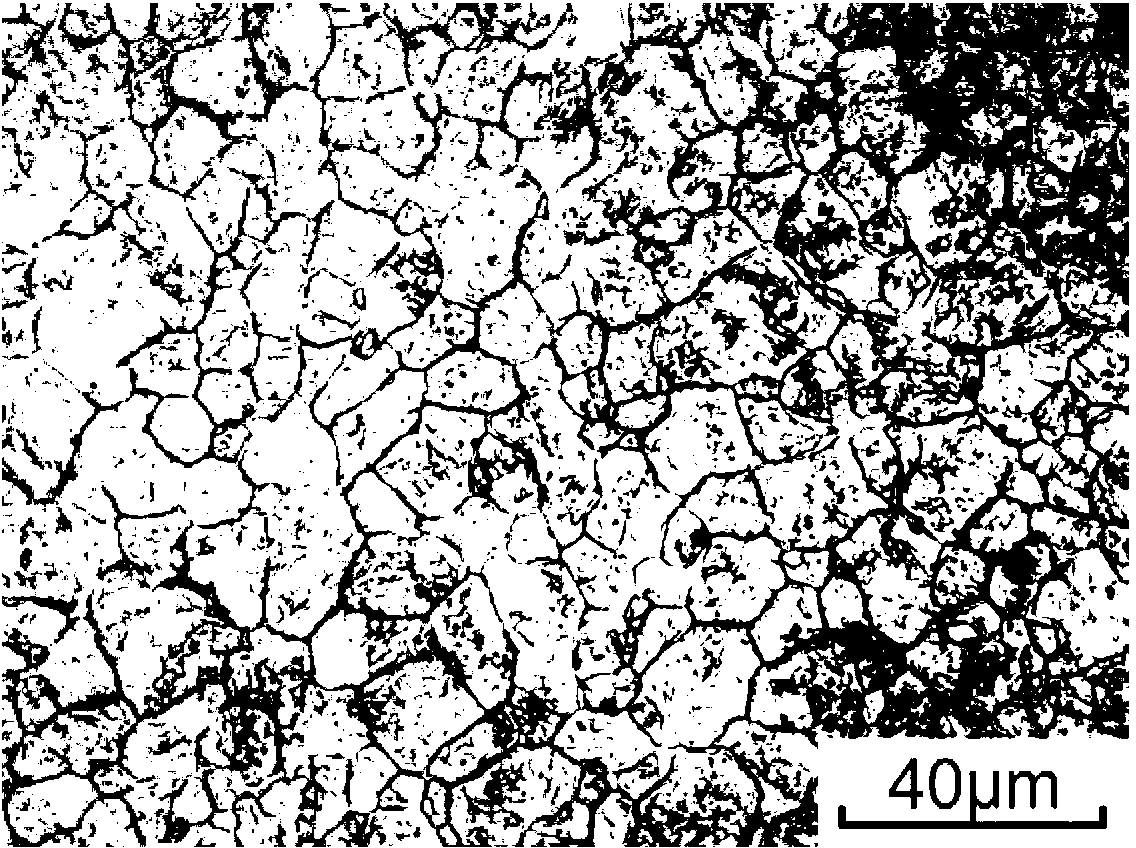Method for displaying and treating Cr12 type martensitic heat-resistant steel primary austenite grain boundary
A technology for displaying processing methods and austenite grain boundaries, which is applied in the field of metallographic preparation and can solve problems such as difficulty in displaying grain boundaries
- Summary
- Abstract
- Description
- Claims
- Application Information
AI Technical Summary
Problems solved by technology
Method used
Image
Examples
Embodiment 1
[0029] Select 10Cr12Ni3Mo2VN as the sample, and carry out the processing method of displaying the grain boundary of the steel body prior to austenite. The chemical composition of the 10Cr12Ni3Mo2VN is: C: 0.11%, Si: 0.20%, Mn: 0.75%, Cr: 11.8%, Ni: 2.7%, Mo: 1.7%, V: 0.3%.
[0030] The processing method includes the following steps:
[0031] Step 1. First cut a 10×12×15mm block sample, place one of the planes of the sample on 240#, 400#, 600#, 800#, 1000# (that is, the particle size is 240 mesh, 400 mesh, 600 mesh, respectively). mesh, 800 mesh, 1000 mesh) on metallographic sandpaper from coarse to fine.
[0032] Before changing the sandpaper each time, ensure that there is no scratch on the surface of the sample perpendicular to the polishing direction. When changing the sandpaper, the sample is rotated at an angle of 90 degrees, and finally polished with 1000# sandpaper.
[0033] Step 2. Raise the temperature of the heating furnace to a predetermined temperature, and then ...
Embodiment 2
[0039] 12Cr12 is selected as the sample for the processing method of displaying the grain boundary of prior austenite in the steel body, wherein the chemical composition of the selected 12Cr12 is: C≤0.15%, Si≤0.50%, Mn≤1.00%, P≤0.040%, S≤0.030%, Ni≤0.60%, Cr: 11.50%-13.00%.
[0040] The processing method includes the following steps:
[0041] Step 1. First cut a 10×12×15mm block sample, and polish one of the planes of the sample on 320#, 600#, 800#, 1000# metallographic sandpaper from coarse to fine.
[0042] Before changing the sandpaper each time, ensure that the polished surface of the sample has no scratches perpendicular to the polishing direction. When changing the sandpaper, the sample is rotated at an angle of 90 degrees, and finally polished with 1000# sandpaper.
[0043] Step 2. Raise the temperature of the heating furnace to a predetermined temperature, and then put the polished sample into the heating furnace, wherein the polished surface is in contact with the ai...
Embodiment 3
[0048] Select 10Cr12Ni3Mo2VN as the treatment method for the sample to display the grain boundary of prior austenite in steel body.
[0049] The processing method includes the following steps:
[0050] Step 1. First cut a 10×12×15mm block sample, and polish one of the planes of the sample on 240#, 400#, 600#, 800#, 1200# metallographic sandpaper from coarse to fine.
[0051] Before changing the sandpaper each time, ensure that there is no scratch on the surface of the sample perpendicular to the polishing direction. When changing the sandpaper, the sample is rotated at an angle of 90 degrees, and finally polished with 1200# sandpaper.
[0052] Step 2. Raise the temperature of the heating furnace to a predetermined temperature, and then put the polished sample into the heating furnace, wherein the polished surface is in contact with the air, and keep the temperature for a predetermined time. After the heat preservation is completed, the sample is quenched.
[0053] Step 3. Wat...
PUM
| Property | Measurement | Unit |
|---|---|---|
| particle size | aaaaa | aaaaa |
| particle size | aaaaa | aaaaa |
Abstract
Description
Claims
Application Information
 Login to View More
Login to View More - R&D
- Intellectual Property
- Life Sciences
- Materials
- Tech Scout
- Unparalleled Data Quality
- Higher Quality Content
- 60% Fewer Hallucinations
Browse by: Latest US Patents, China's latest patents, Technical Efficacy Thesaurus, Application Domain, Technology Topic, Popular Technical Reports.
© 2025 PatSnap. All rights reserved.Legal|Privacy policy|Modern Slavery Act Transparency Statement|Sitemap|About US| Contact US: help@patsnap.com



